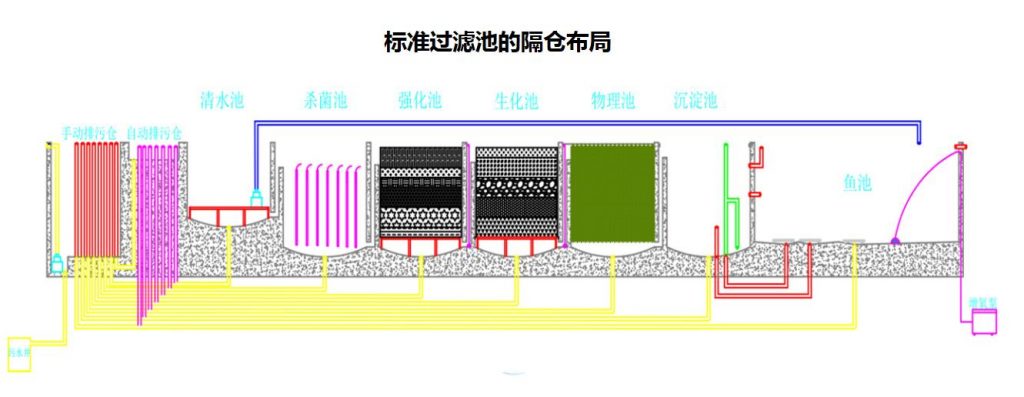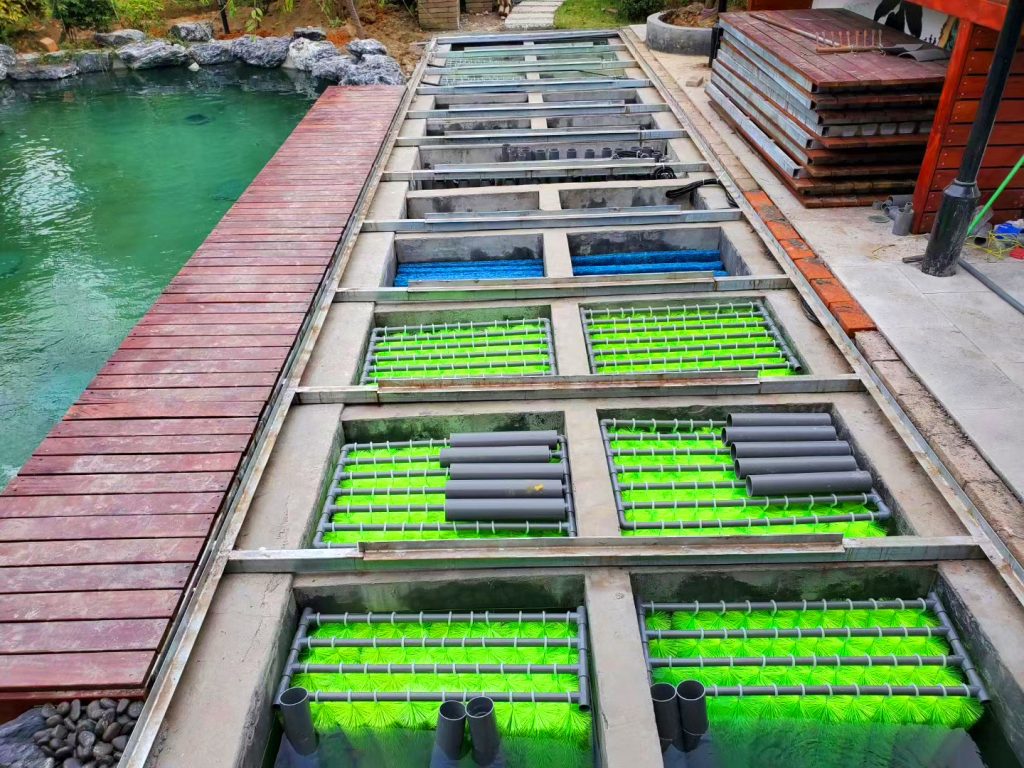Project Cases
contact details
 Ollies (Guangzhou) Recreation and Sports Equipment Co.
Ollies (Guangzhou) Recreation and Sports Equipment Co.Tel: (020) 82686289
Fax: 020-82694853
Headquarter: No.31-37, Xincun 2 Road, Shangjiang North Street, Dongzhou Village, Xintang Town, Zengcheng City, Guangzhou, Guangdong, China
How to design a traditional filtration tank for a fish pond
The design of a traditional fish pond filtration tank typically includes several key steps and elements:
1. Determine the location and size of the filtration basin:
- The filter should be located at one end or corner of the fishpond to allow for easy channeling of water flow.
- Determining the size of the filtration tank is usually based on the size of the tank and the number of fish.

2. Planning of the structure of the filtration basin:
- Filtration ponds typically consist of multiple compartments, including a sedimentation compartment, a physical filtration compartment, a biochemical filtration compartment, and a clear water compartment.
3. Design of sedimentation bins:
- This is the first compartment of the filter tank and is used to settle larger solid particles.
- They are usually designed to be larger to slow down the flow of water and allow heavy materials to settle.
4. Design of physical filtration bins:
- Immediately following the sedimentation bin, it is used to remove smaller particles and suspended matter.
- Use filter materials such as sponges, filter wool or other porous materials.

5. Design of biochemical filtration bins:
- Used to cultivate beneficial bacteria to break down ammonia and nitrite in fish feces.
- Materials used include ceramic rings, biospheres, and volcanic rocks that provide a large surface area for bacteria to attach to.
6. Design of clean water silos:
- A final compartment for storing filtered water, which is then pumped back to the fish pond.
- Can be designed with shallower bins for easier cleaning and maintenance.
7. Water flow design:
- Ensure that water flows evenly through each chamber to avoid the formation of stagnant areas.
- Use pumps and piping systems to control the direction and speed of water flow.
8. Pipelines and pumps:
- Select a suitable pump to ensure that its flow rate and head are appropriate for the needs of the filter tank.
- Design of the piping system, including inlet pipes, outlet pipes and pipes connecting the various bins.

9. Maintenance and cleaning:
- Design filtration basins that are easy to clean and maintain so that the filter material can be replaced and the sediment cleaned on a regular basis.
10. Aesthetics and concealment:
- If possible, design the filtration pond to blend in with its surroundings or hide it in the landscape.
11. Security considerations:
- Ensure that the filter tank is structurally sound to avoid collapse or damage.
- Ensure the safety of pumps and electrical equipment to avoid the risk of electrocution.
12. Budget and selection of materials:
- Choose the right material according to your budget, such as plastic, concrete or stone.

13. Environmental impact:
- Consider the impact of the filtration pond on the surrounding environment, such as noise and visual impacts.
14. Backup systems:
- Consider designing a backup filtration system in case the primary filtration system fails.
15. Automation and monitoring:
- If possible, consider automated systems to monitor the operational status of the filtration basin, such as an automated backwash system.
When designing a traditional fish pond filtration tank, the specific needs of the pond and environmental conditions should be taken into account to ensure the effectiveness and sustainability of the filtration system.
Related content
- Koi Pond Maintenance and Protection Guide during the Rainy Season | The Veteran Driver's Handbook of Dampness and Disease Prevention
- Pool water circulation system maintenance guide, goodbye to cloudy water quality to create four seasons of translucent "liquid sapphire".
- From zero to professional: a complete guide to pool equipment configuration that even a beginner can understand
- The Golden Ratio of Swimming Pool Ventilation and Dehumidification Systems: The Balancing Act of Airflow, Humidity and Energy Consumption
- Specific benefits of dehumidifiers for new swimming pools
- Industrial solutions for fish pond water quality management: How to break through the bottleneck of traditional operation and maintenance of filtration systems?
- Theoretical and empirical study on the design of fish pond filtration system with ultra-volumetric capacity.
- Fish Pond Filter Professional Maintenance Guide